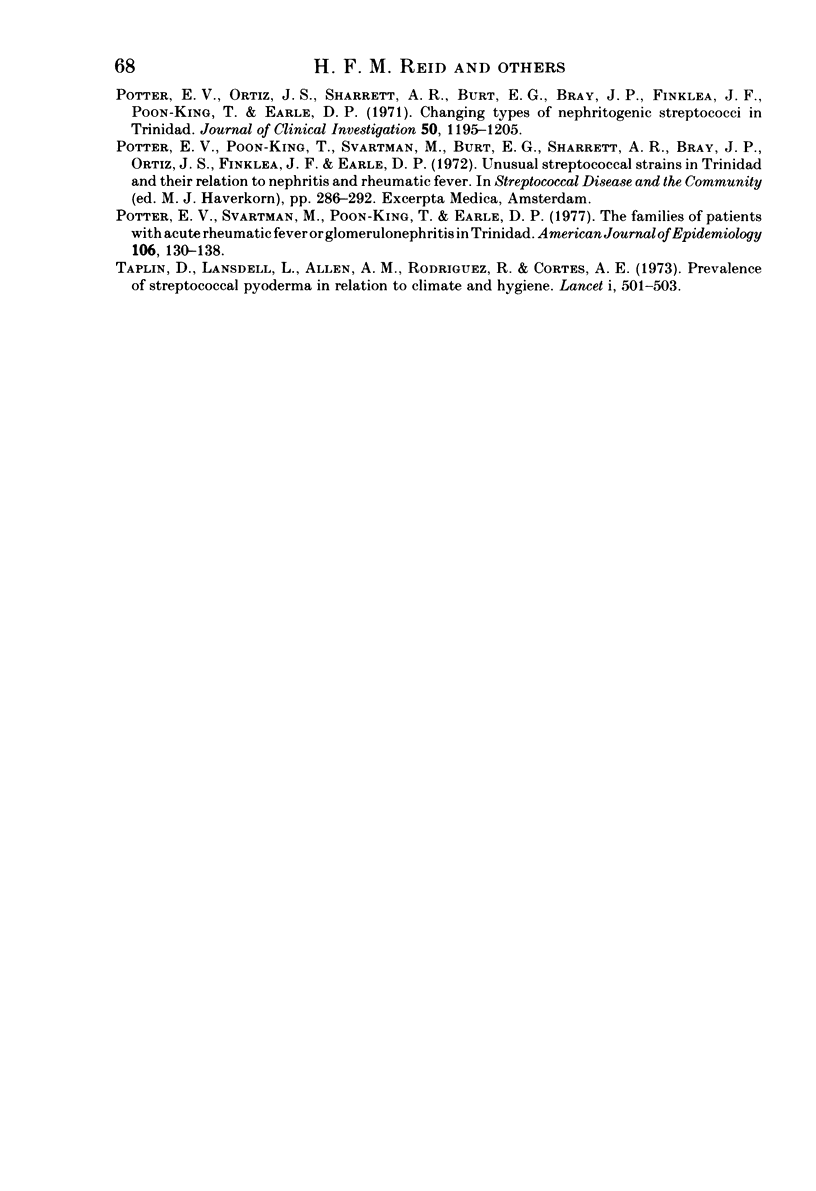Abstract
The group G streptococcus has generally not been considered a prominent pathogen. In a 1982 study of the colonization rate by beta-haemolytic streptococci in apparently healthy children, age 5-11 years, 25 of 69 isolates belonged to group G. This surprisingly high rate of group G colonization (14.3%) led to a retrospective study of school surveys in 1967 which showed that the colonization rate with this organism was 2.3% (range 1.3-3.5%). A review of bacitracin-sensitive streptococcal isolates from hospital admissions of patients with acute glomerulonephritis (AGN), rheumatic fever, and their siblings, between January 1967 and July 1980, was conducted. Of 1063 bacitracin-sensitive isolates, 63 were group G, and 52 of these were isolated from AGN patients and their siblings, i.e. 7 from skin lesions of AGN patients, 40 from the throats of siblings and only 5 from the skins of the siblings. The other 11 group G isolates were from rheumatic-fever patients and their siblings. Thus, the group G colonization rate fluctuates in the population. The isolation of only group G streptococci from skin lesions of patients with AGN suggests a possible association between group G streptococcal pyoderma and acute post-streptococcal glomerulonephritis.
Full text
PDF







Selected References
These references are in PubMed. This may not be the complete list of references from this article.
- Armstrong D., Blevins A., Louria D. B., Henkel J. S., Moody M. D., Sukany M. Groups B, C, and G streptococcal infections in a cancer hospital. Ann N Y Acad Sci. 1970 Oct 30;174(2):511–522. doi: 10.1111/j.1749-6632.1970.tb45577.x. [DOI] [PubMed] [Google Scholar]
- Baker C. J. Unusual occurrence of neonatal septicemia due to group G streptococcus. Pediatrics. 1974 Apr;53(4):568–570. [PubMed] [Google Scholar]
- Belcher D. W., Afoakwa S. N., Osei-Tutu E., Wurapa F. K., Osei L. Letter: Non-group A streptococci in Ghanaian patients with pyoderma. Lancet. 1975 Nov 22;2(7943):1032–1032. doi: 10.1016/s0140-6736(75)90308-6. [DOI] [PubMed] [Google Scholar]
- Brans Y. W. LETTER: Group G streptococcal sepsis. Pediatrics. 1975 May;55(5):745–746. [PubMed] [Google Scholar]
- Christensen K. K., Christensen P., Flamholc L., Ripa T. Frequencies of streptococci of groups A, B, C, D, and G in urethra and cervix swab specimens from patients with suspected gonococcal infection. Acta Pathol Microbiol Scand B Microbiol Immunol. 1974 Aug;82(4):470–474. doi: 10.1111/j.1699-0463.1974.tb02355.x. [DOI] [PubMed] [Google Scholar]
- Dyson A. E., Read S. E. Group G streptococcal colonization and sepsis in neonates. J Pediatr. 1981 Dec;99(6):944–947. doi: 10.1016/s0022-3476(81)80029-7. [DOI] [PubMed] [Google Scholar]
- Maxted W. R., Potter E. V. The presence of type 12 M-protein antigen in group G streptococci. J Gen Microbiol. 1967 Oct;49(1):119–125. doi: 10.1099/00221287-49-1-119. [DOI] [PubMed] [Google Scholar]
- McCue J. D. Group G streptococcal pharyngitis. Analysis of an outbreak at a college. JAMA. 1982 Sep 17;248(11):1333–1336. doi: 10.1001/jama.248.11.1333. [DOI] [PubMed] [Google Scholar]
- Nieburg P. I. Fatal group G streptococcal sepsis in a neonate. Scand J Infect Dis. 1979;11(1):93–95. doi: 10.3109/inf.1979.11.issue-1.17. [DOI] [PubMed] [Google Scholar]
- Nordlander I. M., Thal E., Tunevall G. Occurrence and significance of hemolytic streptococci groups b-u in human infectious disease. Scand J Infect Dis. 1975;7(1):35–38. doi: 10.3109/inf.1975.7.issue-1.06. [DOI] [PubMed] [Google Scholar]
- Parker M. T. Streptococcal skin infection and acute glomerulonephritis. Br J Dermatol. 1969;81(Suppl):37+–37+. doi: 10.1111/j.1365-2133.1969.tb12832.x. [DOI] [PubMed] [Google Scholar]
- Potter E. V., Ortiz J. S., Sharrett A. R., Burt E. G., Bray J. P., Finklea J. F., Poon-King T., Earle D. P. Changing types of nephritogenic streptococci in Trinidad. J Clin Invest. 1971 Jun;50(6):1197–1205. doi: 10.1172/JCI106597. [DOI] [PMC free article] [PubMed] [Google Scholar]
- Potter E. V., Svartman M., Poon-King T., Earle D. P. The families of patients with acute rheumatic fever or glomerulonephritis in Trinidad. Am J Epidemiol. 1977 Aug;106(2):130–138. doi: 10.1093/oxfordjournals.aje.a112442. [DOI] [PubMed] [Google Scholar]
- Taplin D., Lansdell L., Allen A. M., Rodriguez R., Cortes A. Prevalence of streptococcal pyoderma in relation to climate and hygiene. Lancet. 1973 Mar 10;1(7802):501–503. doi: 10.1016/s0140-6736(73)90324-3. [DOI] [PubMed] [Google Scholar]


